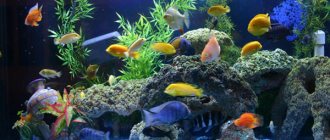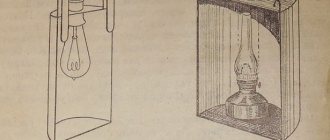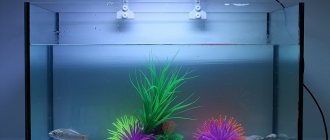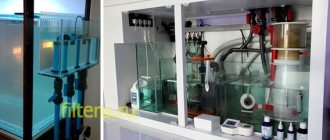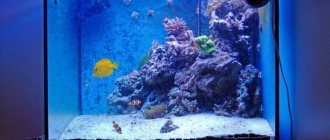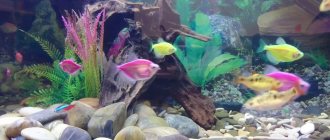Sales consultants in specialized stores always strive to sell as many products as possible that accompany the main purchase. Therefore, when asked directly whether a filter is needed in an aquarium, you will definitely be answered in the affirmative and will even be offered help in choosing. In reality, a lot depends on the situation. With the right combination of flora and fauna, the model can exist without a filter. Just 20-30 years ago, such technical equipment was a novelty, and many aquarists simply did not use them.
Why do you need a filter?
This device, consisting of a pump and a cartridge with filter material, is intended for mechanical, biological and chemical cleaning of the environment. Mechanical - removing suspended impurities from water, in other words, garbage. Biological filtration, in addition to debris, removes hazardous substances, such as ammonia. Chemical removes substances dissolved in it from a liquid, including ammonia, as well as odors. In addition, the device gently mixes the water in the vessel. There are different types of filters depending on the cleaning method, but most modern models, except the cheapest ones, combine several methods.
The best models
Barbus ViPi-300F - for a 5 liter container
Internal plastic filter with aerator and flute, designed for reptiles and fish. Power consumption - 2 W. Filtration type: mechanical (fine-pored sponge). Evenly distributes water flows without creating large water movements. The kit includes a set of additional attachments that expand the functionality of the device: “Filtration and sprinkling”, “Circulation and filtration”, “Aeration and filtration”.
Advantages:
- High productivity (up to 30 volumes of water per hour);
- Economical energy consumption;
- Organic design;
- Quiet operation;
- Simplicity of the device, ease of assembly and installation;
- Possibility of aeration (saturation of water with air bubbles);
- Small sizes.
Flaws:
- Plastic parts quickly lose their attractiveness, are fragile and brittle;
- It is necessary to clean the sponge regularly;
- There is no protection against bacteriological contamination of water;
- Inconvenient to clean.
Laguna – “Laguna” – for 7l.
Powerful internal silent filter for cleaning and aerating water in freshwater and marine aquariums.
Can be installed in parallel with other purifiers (for example, biological). The small and isolated rotor chamber ensures silent operation.
Advantages:
- The presence of an air pipe for water aeration;
- Simple design;
- Ease of installation and operation;
- High productivity (up to 20 own volumes per hour);
- Formation of small water streams during operation.
- Small sizes (4.3x3x8 cm);
Flaws:
- Possible detachment from the walls of the aquarium;
- The need to periodically replace the filter material;
- Rapid clogging of tubes.
Sea Star "HX-200L - for 10 liter
Internal powerful plastic filter with economical energy consumption of 2 W, designed for purifying water in freshwater aquariums. Subject to full immersion. The cleaning method is mechanical. The device has four strong suction cups for attaching to the inner glass.
Advantages:
- Small sizes (5x4x11 cm);
- Easy to assemble, disassemble and clean;
- Quiet in operation;
- Has a small mass;
- Has high productivity (up to 20 own volumes per hour);
- The sponge is located under the housing cover, so it can be easily removed and washed.
Flaws:
- Unaesthetic appearance (black color);
- The need to periodically replace plastic parts;
- There is no protection against bacterial contamination.
Tetra Brillant-Filter - for 15 liter
High-performance German internal filter for freshwater and marine aquariums.
Ensures uniform formation of water flows, effectively filters pathogenic bacteria and prevents the proliferation of algae.
Mixed type of cleaning (mechanical + biological). The design provides a regulating outlet for water flows.
Advantages:
- Safe for fish (the sponge is made of dense non-toxic material);
- Easy installation and cleaning;
- Easy to use.
Flaws:
- Low efficiency without installing an additional compressor from the same manufacturer;
- Intended for fish only;
- Large sizes (tube with a diameter of 2 cm and a length of 20 cm, a filter housing with a diameter of 5 cm and a length of 11 cm).
Xilong XL-F 580 – for 20 l.
Highly internal type filter with a filtration rate of 300 liters per hour, designed for cleaning and uniform distillation of water. Mechanical filtration type. Medium density synthetic sponge is used as filler.
Advantages:
- Simplicity of assembly, ease of installation and use;
- Long service life;
- Compactness;
- Simple filter bottom design, allowing easy removal and installation of filter media.
Flaws:
- Monotonous quiet noise during operation;
- Rapid contamination;
- Often there is a need to change the sponge to a fine-pored one.
Aquael Wersamax FZN-mini – 25 liters
External cascade aquarium filter of the “waterfall” type. Designed for cleaning and aerating water in freshwater and marine aquariums.
It has high productivity and a filtration rate of up to 230 liters per hour, intensively filters water. Thanks to the modern “waterfall” design, improved water aeration is achieved.
Combined filtration type. An ultraviolet diode prevents the growth of fungi and algae.
Advantages:
- Quiet operation;
- Low power consumption;
- Easy to assemble, disassemble and install;
- Availability of a special compartment for the pump;
- Possibility of connecting an ultraviolet sterilizer.
Flaws:
- Creation of large flows of water;
- Possibility of pump failure and the need to replace it;
- Only the headset is suitable.
Aquael Fan micro - 30 l
Internal type filter with flow regulator, designed for purification and aeration of water. It is resistant to dirt and does not require special cleaning measures due to the unique structure of the sponge located on the perforated rod. It has a plastic prefilter that traps large debris particles.
The kit includes a special retention chamber for filtration media to prevent dirty water from entering while cleaning the device. Productivity – 250 liters per hour (up to 8 volumes).
Advantages:
- Presence of a prefilter;
- Simple design;
- Ease of installation;
- Sealed rotor chamber,
- Quiet operation;
- Effective retention of dirt particles of any size;
- Prevention of bacterial contamination of water;
- Ability to regulate performance without immersing your hands in water;
Flaws:
- Periodic replacement of filter components is necessary;
- Weakness of suckers;
- Energy consumption is higher compared to other models - 4 W.
Depending on the size, number of inhabitants and type of aquarium water, an artificial pond can be equipped with various filter systems. Filters for small aquariums have a special design that allows you to combine silent and effective water purification with high motor power and low energy consumption.
In addition to ridding the aquarium of debris and preventing microbial contamination, both external and internal modern filters ensure that the water is saturated with air bubbles, and also create the necessary water flows that maintain the ecological and biological balance of the entire aquarium.
Other interesting articles
- How to set up a 40-liter fish aquarium A 40-liter aquarium is a real milestone in becoming an aquarist. This is the same volume in which...
- How to glue a 500-liter aquarium with your own hands Glass rectangular aquariums with fish that decorate the interior of homes, offices and shopping centers are familiar to every fan...
- Do fish need light at night? Do fish need light in an aquarium at night? The condition of aquarium fish and aquatic plants is largely determined by...
How to set up an aquarium without a filter
The cleaning device improves the habitat of aquatic flora and fauna. But if, nevertheless, the owner decides to do without installing it, it is necessary to create an alternative in the aquarium - an autonomous biosystem that independently regulates its biological balance. The role of a filter in it will be performed by soil and colonies of beneficial bacteria.
Success is largely determined by the correct choice of tank. The smaller the volume, the more difficult it is to create in it the conditions necessary for normal existence. The optimal choice is 50 liters, but you must take into account the volume required by the fish you plan to stock. It is very important to avoid overcrowding, because it causes an excess of nitrogen-containing waste - natural filters cannot cope with it. It is advisable to reduce the recommended occupancy rate by one and a half times.
Fish in an aquarium without a filter can live unpretentiously. The absence of a cleaning device is well tolerated by guppies, swordtails, neons, gouramis, barbs, macropods, cardinals, zebrafish, and some subspecies of goldfish. Caring for them is the same as with filtration, but it is especially important not to overfeed or allow food residues to accumulate.
The crucial moment is the selection, preparation and laying of the soil. It is preferable to choose a porous material so that colonies of beneficial bacteria settle in it. You cannot use a substrate that is either too small (it will cake and rot) or too large (remnants of feed and railway waste will fall under it and also rot). Before laying, the soil must be thoroughly washed and disinfected as much as possible.
An aquarium without a filter needs dense vegetation to enrich the environment with oxygen and biological purification. Priority is given to fast-growing grasses with an extensive root system. Good choices are Vallisneria, Elodea, Cryptocoryne undulata, Anubias bartera, and pterygoid fern. Echinodorus will help fight siltation and acidification of the soil. Mosses, for example, Javanese, purify water well, but grow slowly, so they are used as additional flora.
Which should it be?
Filters for aquariums up to 30 liters can be either external (waterfalls or canister) or internal. The main requirement for a cleaning device is a combination of small size with high performance and safety for aquarium fish.
General requirements:
- Regardless of the type and size, all devices must have high-quality fastenings to the walls of the aquarium.
- A small device is preferable, which will not take up much useful space inside the aquarium.
- Filtration materials must be removed from the water without disassembling the housing.
- The power (operating speed) must exceed the volume of the aquarium and be at least 8-15 own volumes per hour with an energy consumption of 1.5 to 4 W.
This is due to the fact that the rate of water purification is calculated for each device under “ideal” conditions, where there are no fish, soil and aquarium plants. When immersed in a finished aquarium, the power of operation changes.
- During operation, significant flows of water should not form that interfere with the movement of fish.
- The smallest inhabitants of the aquarium can get into the water collectors, so their tubes should be equipped with a protective mesh or a fine-pored sponge.
- The design should be simple and compact, the filter itself should be easy to assemble and install.
- Water purification should affect weed particles of any size - from feed to large debris.
- Preferred are devices with a combined filtration mechanism (mechanical, chemical and biological cleaning methods + the ability to install an ultraviolet sterilizing diode).
Aquarium care without filtration
The normal existence of the ecosystem depends on how to care for an aquarium without a filter. There are a few specific points to pay attention to:
- Biological equilibrium after launch will be established no earlier than in a month. Do not take any measures if during this period the water slightly darkens or becomes cloudy several times, and then becomes clear again.
- Weekly it is necessary to change 15-20% of the water, for this use settled tap water.
- Combine the replacement with cleaning the bottom from dirt - siphon the soil. Add fresh water after cleaning.
- Environmental parameters must be monitored regularly.
- Pay special attention to the fight against algae, which takes away nutrition from plants.
The main thing in maintaining an ecosystem is regularity and scrupulousness, since any pollution will immediately lead to changes in environmental parameters and disruption of the biobalance with all the sad consequences.
What fish can live without aeration (oxygen)
Some fish, which do not need a high oxygen content in the water, are able to use atmospheric air for breathing, due to the presence of special organs or another method (gill labyrinth, intestinal or skin respiration).
Many fish will survive without an artificial supply of oxygen, but only with an open aquarium! Without access to air, fish with additional respiratory organs die. Therefore, the surface of the water should not be completely covered with plants.
Fish that can live without oxygen
Without a filter
These are slider or labyrinth fish, which in the course of evolution have developed additional labyrinthine bone plates with folds of mucous membrane, thanks to which they are also able to use air for breathing in an aquarium without oxygen. Aeration is not necessary for such fish!
Labyrinths include:
- Betta fish (betta fish);
- all gourami;
- ctenopoma;
- macropods (paradise fish);
- swordtails;
- lalius and others.
Lalius
Schooling fish require less volume per individual. Guppies are undemanding to their habitat. A flock of 6 individuals can be kept in a 40-liter tank with several neighbors.
Once a week it is necessary to change the water and siphon the soil!
With filter
Loach and tropical catfish are capable of taking air into a special part of the intestine. The sacbranchial catfish and clarius use epibranchial cavities for breathing. These amazing animals can live for a long time not only without oxygen, but also without water. In nature, they move in this way from one body of water to another.
The most popular among aquarists are bottom-dwelling catfish, for example, speckled catfish. Usually they serve as “orderlies” of household ponds, eliminating food debris. But, like bottom dwellers, they contribute to the rise of suspended matter from the bottom and muddy the water. In an aquarium densely populated with catfish, filtration is necessary.
Speckled catfish
Most fish use skin respiration. In inhabitants of stagnant bodies of warm water, this figure can reach 80% versus the usual 10–20%. Young animals are even less demanding on aeration. These are catfish, eels.
Fish that need a filter but can do without aeration include:
- aquarium catfish;
- acne;
- vines.
The necessary conditions
Aquariums without filtration and aeration require more careful care, including:
- initially competent selection of pets, taking into account species characteristics (aggressiveness, size, living conditions);
- regular cleaning using a siphon;
- partial water changes every 2–3 days;
- strict control of the number of inhabitants to avoid overpopulation;
- timely thinning of the aquarium flora to prevent overgrowing of the home pond;
- Close monitoring of the condition of pets for timely detection of problems and diseases.
Is it worth making a home pond without filtration?
From all that has been said, we can conclude that keeping an aquarium without a filter does not make life much easier for its owner, at least in terms of maintenance. The lack of automatic cleaning will need to be compensated for by constantly maintaining cleanliness yourself. Moreover, if mechanical pollution is easy to detect visually and eliminate, then natural filters may not be able to cope with biological and chemical cleaning, and you will only be able to see the consequences. If you are not sure that you can maintain the required biobalance, it is better to choose a standard equipped option.
Fish that definitely need a filter and oxygen
There is confusion that barbs and goldfish can also live without a filter and oxygen, but this is not true. They require additional equipment (filter, compressor)!
Barbs are suitable for small-volume tanks, especially dwarf ones.
But goldfish in small or round aquariums will live much less than the period given by nature, even with intensive care.
gold fish
Lack of oxygen
There are only a few aquarium phenotypes for which a small percentage of atmospheric gas is not critical. They are durable and easy to care for. Experienced aquarists identify several phenotypes for which the percentage of air in aquarium water is not critical.
- Representatives of the loach family (catfish, some loaches). Aquarium fish use atmospheric air. To absorb, it rises to the upper layer of water, after which it gradually descends to the substrate.
- Labyrinthine phenotypes that can breathe liquefied gas. These species have a special respiratory system, which is presented in the form of a gill labyrinth. At the same time, they absorb air masses in the same way as previous species.
Beginners are interested in which fish can live without oxygen. Having learned about the above phenotypes, which do not require oxygen, they almost completely block access to air. This entails the death of the fauna in the reservoir.

